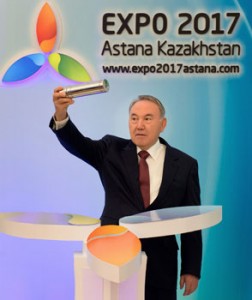 ASTANA – The construction of Astana’s EXPO 2017 facilities was officially launched in a ceremony on April 24, when Kazakh President Nursultan Nazarbayev laid a capsule on the site in the capital that will house the exhibition complex. The President also examined the schedule for the complex’s construction.
ASTANA – The construction of Astana’s EXPO 2017 facilities was officially launched in a ceremony on April 24, when Kazakh President Nursultan Nazarbayev laid a capsule on the site in the capital that will house the exhibition complex. The President also examined the schedule for the complex’s construction.
Addressing the ceremony, Nazarbayev said that the country had not attempted such a large-scale facility before. He noted the innovative properties of the new complex, including mechanisms for harnessing and using wind, solar and other alternative energy.
The complex will be a research base for Nazarbayev University students and scholars to develop new technologies, he said. The university is located next to the future EXPO site. Within the complex 4,000 apartments, a new hotel, a Congress Hall and a 500-metre covered street will be built.
“The covered street will have recreation and shopping facilities and the main, spherical pavilion, 80 metres in diameter and 100 metres high, will have international pavilions around it. A walkway will be laid with all the necessary facilities, too. The construction of the complex will provide a lot of jobs to Kazakh builders and developers, who should demonstrate a high level of professionalism and high-quality work,” the President said.
According to Nazarbayev, EXPO 2017 is also an opportunity to present the achievements of the capital and the country as a whole to the world community.
“Apart from the exhibition itself, we must also showcase our most versatile culture, history and art. This necessitates well-coordinated teamwork between the government, akimat (city administration), ministries and departments,” he said. The President believes the various administrative parties are able to handle this important task and stand before the world in an entirely new light.
Major construction and installation work is scheduled to run from May 2014 to December 2016. The total area of the Astana EXPO 2017 exhibition complex is 174 hectares. The exhibition area will house Kazakhstan’s national pavilion; international, corporate and themed pavilions; shopping and recreation facilities and, outside the main buildings, a conference centre and press centre, a covered street, residential houses and hotels, according to the Akorda press service.


